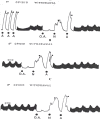Molecules Acting on CB1 Receptor and their Effects on Morphine Withdrawal In Vitro
- PMID: 20111725
- PMCID: PMC2811858
- DOI: 10.2174/1874091X00903010078
Molecules Acting on CB1 Receptor and their Effects on Morphine Withdrawal In Vitro
Abstract
Several pharmacological studies indicate that CB1 cannabinoid receptors (CB1Rs) are present in guinea pig ileum (GPI) and their activation reduce the acetylcholine (Ach) release. Dependence can be induced and measured in vitro by using GPI and the contraction due to opioid withdrawal is caused by acetylcholine release.Design of molecules acting on the CB1Rs are widely studied and the large availaibility of CB1Rs agonists and antagonists provides powerful tools to determine the role of these receptors in mediating some of physiological and pharmacological effects in the myenteric neurones.Given the relationship between CB1Rs/Opioid Withdrawal/Ach system, in the present paper we have designed six new CB1Rs agonists named A-F and evaluated their role in mediating morphine withdrawal in GPI. Also, a comparative study was performed by using the CB1Rs synthetic cannabinoid WIN 55,212-2 and CP 55,940. The results of our experiments indicate that both WIN 55,212-2 and CP 55,940 (1x10(-8)-5x10(-8)-1x10(-7) M) were able to reduce morphine withdrawal in a concentration-dependent manner. Very similar results were obtained with the new CB1Rs agonists (A-F) used at same concentrations. The results of our experiments indicate that CB1Rs are involved in the control of morphine withdrawal in vitro thus confirming an important functional interaction between the cannabinoid and opioid system.
Keywords: Ach. CB1 receptors; guinea-pig ileum.; morphine; withdrawal.
Figures

Similar articles
-
Beta-endorphin fragments DTgammaE and DEgammaE reduced morphine inhibition of electrically-induced contractions and opiate withdrawal.Med Chem. 2009 Mar;5(2):165-70. doi: 10.2174/157340609787582864. Med Chem. 2009. PMID: 19275715
-
Inhibition by cannabinoid receptor agonists of acetylcholine release from the guinea-pig myenteric plexus.Br J Pharmacol. 1997 Aug;121(8):1557-66. doi: 10.1038/sj.bjp.0701301. Br J Pharmacol. 1997. PMID: 9283688 Free PMC article.
-
Involvement of the cannabinoid CB1 receptor in the opioid inhibition of the response to cholecystokinin and acute withdrawal response.Neurotoxicology. 2005 Oct;26(5):819-27. doi: 10.1016/j.neuro.2005.03.010. Neurotoxicology. 2005. PMID: 15913779
-
Cannabinoids and the gastrointestinal tract.Gut. 2001 Jun;48(6):859-67. doi: 10.1136/gut.48.6.859. Gut. 2001. PMID: 11358910 Free PMC article. Review.
-
Behavioral effects of cannabinoid agents in animals.Crit Rev Neurobiol. 1999;13(3):243-81. doi: 10.1615/critrevneurobiol.v13.i3.20. Crit Rev Neurobiol. 1999. PMID: 10803637 Review.
Cited by
-
Modulation of histone deacetylase attenuates naloxone-precipitated opioid withdrawal syndrome.Naunyn Schmiedebergs Arch Pharmacol. 2012 Jun;385(6):605-19. doi: 10.1007/s00210-012-0739-x. Epub 2012 Feb 25. Naunyn Schmiedebergs Arch Pharmacol. 2012. PMID: 22362134
-
In vivo and in vitro attenuation of naloxone-precipitated experimental opioid withdrawal syndrome by insulin and selective KATP channel modulator.Psychopharmacology (Berl). 2015 Jan;232(2):465-75. doi: 10.1007/s00213-014-3680-5. Epub 2014 Jul 26. Psychopharmacology (Berl). 2015. PMID: 25059539
-
Ammonium pyrrolidine dithiocarbamate and RS 102895 attenuate opioid withdrawal in vivo and in vitro.Psychopharmacology (Berl). 2012 Mar;220(2):427-38. doi: 10.1007/s00213-011-2489-8. Epub 2011 Sep 20. Psychopharmacology (Berl). 2012. PMID: 21931991
References
-
- Lynn A.B, Herkenham M. Localization of cannabinoid receptors and nonsaturable high-density cannabinoid binding sites in peripheral tissues of the rat: implications for receptor-mediated immune modulation by cannabinoids. J. Pharmacol. Exp. Ther. 1994;268:1612–23. - PubMed
-
- Martin B.R, Wiley J.L. Mechanism of action of cannabinoids: how it may lead to treatment of cachexia, emesis, and pain. J. Support. Oncol. 2004;2:305–16. - PubMed
-
- Pazos MR, Núñez E, Benito C, Tolon RM, Romero J. Role of the endocannabinoid system in Alzheimer's disease: New perspectives. Life Sci. 2004;75:1907–15. - PubMed
-
- Lichtman AH, Martin BR. Spinal and supraspinal mechanisms of cannabinoid-induced antinociception. J. Pharmacol. Exp. Ther. 1991;258:517–23. - PubMed
LinkOut - more resources
Full Text Sources
Miscellaneous
